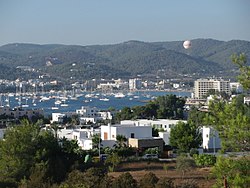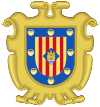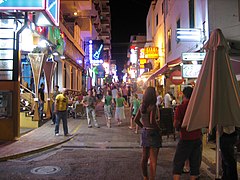Sant Antoni de Portmany
Sant Antoni de Portmany
This article is written like a manual or guidebook. (April 2019) (Learn how and when to remove this template message) |
Sant Antoni de Portmany | |
|---|---|
Town | |
 Sant Antoni Bay | |
| Coordinates: 38°58′51″N 1°18′2″E / 38.98083°N 1.30056°ECoordinates: 38°58′51″N 1°18′2″E / 38.98083°N 1.30056°E | |
| Country | Spain |
| Autonomous community | Balearic Islands |
| Province | Balearic Islands |
| Island | Ibiza |
| Government | |
| • Mayor | Josep Tur 'Cires' (PSIB) |
| Area | |
| • Total | 127 km2 (49 sq mi) |
| Elevation (AMSL) | 31 m (102 ft) |
| Population (2012) | |
| • Total | 22,446 |
| • Density | 180/km2 (460/sq mi) |
| Time zone | UTC+1 (CET) |
| • Summer (DST) | UTC+2 (CEST (GMT +2)) |
| Postal code | 07820 |
| Area code(s) | +34 (Spain) + 971 (Baleares) |
| Website | Town Hall |
Sant Antoni de Portmany (Catalan pronunciation: [ˈsant ənˈtɔni ðə purˈmaɲ], Spanish: San Antonio Abad) or San Antonio[1][2] is a town on the western coast of Ibiza. It is the second-largest town and municipality in Ibiza; an island described by Time Out magazine as "arguably the clubbing capital of the universe".[3] The town is situated on Sant Antoni Bay on the west coast of the island, part of the Spain autonomous community of the Balearic Islands.
History[edit]
For two thousand years, Sant Antoni was a small fishing village that rose from the Roman natural harbor Portus Magnus, but it began to grow in the late 1950s when many hotels and tourist resorts were built as part of a mass tourism initiative which took place across Spain. As the number of tourists grew, the development of bars, hotels and other tourist infrastructure spread right around to the other side of San Antonio bay, as far as Cala de Bou which lies in the adjacent municipality of Sant Josep de sa Talaia. Since the 1980s British tourists have made up the majority of summertime visitors to San Antonio.[citation needed]
The Egg[edit]
The Egg is the best known landmark in Sant Antoni, located in the centre of the main roundabout at the entrance to the town.[citation needed]
The Egg is a statue erected in the early 1990s to commemorate the local claim of having been the birthplace of Christopher Columbus (there is a similar claim that Hannibal was born in the region). The statue is in the shape of an egg, containing at its centre a model of his ship: the Santa Maria.[citation needed]
The choice of an egg comes from a story about Columbus, who when seeking funding for his Western route to the Indies, was told it was impossible. He then allegedly asked if standing an egg upright was impossible, and when told that it was, he cracked the base of an egg, thus making it possible for it to stand upright. He was then granted funding. See Egg of Columbus.[citation needed]
Passeig de ses Fonts[edit]
Part of Sant Antoni's harbourside promenade, Passeig de ses Fonts, is an area which was developed in the early 1990s to improve the appearance of the town. There are many plants, including palm trees and rubber plants, as well as large fountains, which are illuminated by night. Across the square are a host of restaurants and cafés offering a view over Sant Antoni Bay. It is also the best place[citation needed] from which to watch the massive fireworks display which celebrates the fiesta of Saint Bartholomew on 24 August.[citation needed]
West End[edit]
The 'West End' is an area of San Antonio. Only a couple of streets wide; the main street is the Carrer de Santa Agnès, it hosts a variety of bars ranging from the dance and house music Ibiza is famed for to rock and indie music. PR staff line the street trying to attract tourists into any of the many bars on the strip with special deals on alcohol. It is also the location of the Island's only strip & lap dancing club: Taboo. Bars on the street open as early as 10am for breakfasts and continue to steadily open throughout the day for sports or afternoon entertainment until everything is open by 11pm and then everything closes again at 3am. Originally the name "The West End" refers to a night time minibus trip from hotels in Es Cana in the 1970s that would come to San Antonio's bars (as Es Cana had no bar scene) and the name of this tour package was "The West End Experience". Since then the area has become known simply as "The West End".
Sunset Strip[edit]
Along the coast of the natural bay of San Antonio de Portmany in the west is the Sunset Strip - a venue where visitors to the island meet at sunset at various bars including the Cafe del Mar, Café Mambo, where the likes of Swedish House Mafia, Carl Cox, David Guetta and Pete Tong DJ on a regular basis. The west-facing strip of coastline means that it faces the sunset. Mint Lounge Bar, Café Savannah, Fresh Ibiza and Café del Mar are situated here.[citation needed] Café Del Mar is one of the iconic Ibiza venues that has played an integral part in the evolution of the island over the last four decades.[citation needed]
Ferries and boat cruises[edit]
Among the harbour of San Antonio there are various boats and ferries that have multiple connections to beaches such as Cala Bassa, Cala Compte, Pinet Playa, Es Puet, Cala Grasió, Cala Salada and Port es Torrent. These have daily departures from may until end September or October. Also once a week there is a ferry to Formentera.
Nightclubs[edit]
Sant Antoni is home to two of the main Ibiza nightclubs, Es Paradis, established in 1975, and Eden which was renamed from Kaos in 1999 and renovated in 2013.
Gallery[edit]
See also[edit]
- The Municipality of Sant Antoni de Portmany
References[edit]
- ^ Tess Reidy in San Antonio, Ibiza. "Ibiza: 'Nothing is innocent and dealing is normal' | World news | The Observer". Theguardian.com. Retrieved 18 September 2013.
- ^ "BBC News - Holidaymaker Grant Weston from Pembroke dies in Ibiza fall". Bbc.co.uk. 14 August 2013. Retrieved 18 September 2013.
- ^ World's best clubbing destinations
External links[edit]
| Wikivoyage has a travel guide for Sant Antoni de Portmany. |












Comments
Post a Comment